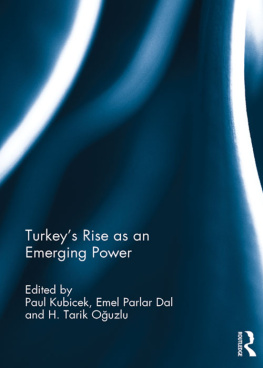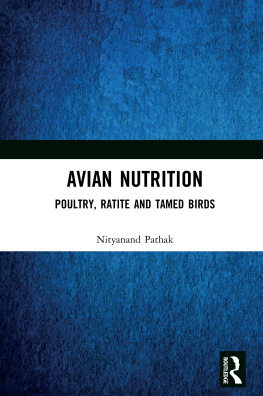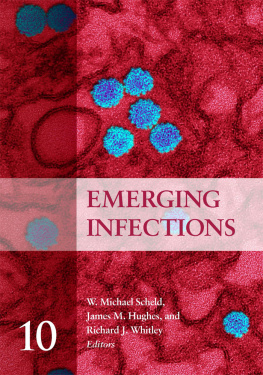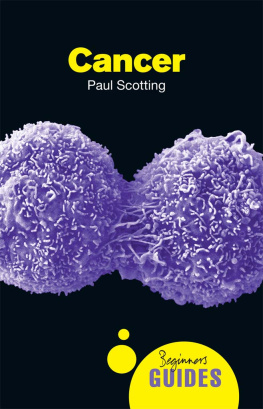Paul - Emerging Avian Disease
Here you can read online Paul - Emerging Avian Disease full text of the book (entire story) in english for free. Download pdf and epub, get meaning, cover and reviews about this ebook. City: Berkeley, year: 2012, publisher: University of California Press, genre: Romance novel. Description of the work, (preface) as well as reviews are available. Best literature library LitArk.com created for fans of good reading and offers a wide selection of genres:
Romance novel
Science fiction
Adventure
Detective
Science
History
Home and family
Prose
Art
Politics
Computer
Non-fiction
Religion
Business
Children
Humor
Choose a favorite category and find really read worthwhile books. Enjoy immersion in the world of imagination, feel the emotions of the characters or learn something new for yourself, make an fascinating discovery.

- Book:Emerging Avian Disease
- Author:
- Publisher:University of California Press
- Genre:
- Year:2012
- City:Berkeley
- Rating:4 / 5
- Favourites:Add to favourites
- Your mark:
- 80
- 1
- 2
- 3
- 4
- 5
Emerging Avian Disease: summary, description and annotation
We offer to read an annotation, description, summary or preface (depends on what the author of the book "Emerging Avian Disease" wrote himself). If you haven't found the necessary information about the book — write in the comments, we will try to find it.
Paul: author's other books
Who wrote Emerging Avian Disease? Find out the surname, the name of the author of the book and a list of all author's works by series.
Emerging Avian Disease — read online for free the complete book (whole text) full work
Below is the text of the book, divided by pages. System saving the place of the last page read, allows you to conveniently read the book "Emerging Avian Disease" online for free, without having to search again every time where you left off. Put a bookmark, and you can go to the page where you finished reading at any time.
Font size:
Interval:
Bookmark:


T o determine the relative efficacy of DEET versus other insect repellants, Fraidin et al. tested the relative efficacy of seven botanical insect repellents; four products containing N,N- diethyl-m-toluamide, now called N,N-diethyl-3- methylbenzamide (DEET); a repellent containing IR3535 (ethyl butylacetylaminopropionate); three repellent-impregnated wristbands; and a moisturizer that is commonly claimed to have repellent effects. These products were tested in a controlled laboratory environment in which the species of the mosquitoes, their age, their degree of hunger, the humidity, the temperature, and the light-dark cycle were all kept constant.
They found that DEET-based products provided complete protection for the longest duration. Higher concentrations of DEET provided longer-lasting protection. A formulation containing 23.8 percent DEET had a mean complete- protection time of 301.5 minutes. A soybean-oil- based repellent protected against mosquito bites for an average of 94.6 minutes. The IR3535-based repellent protected for an average of 22.9 minutes. All other botanical repellents they tested provided protection for a mean duration of less than 20 minutes. Repellent-impregnated wristbands offered no protection.
They concluded that currently available non- DEET repellents do not provide protection for durations similar to those of DEET-based repellents and cannot be relied on to provide prolonged protection in environments where mosquito- borne diseases are a substantial threat.
Depending on the time in the field, the temperature, exposure to water, perspiration, or concentration of DEET in the product, you may need to re-apply. This study found that a product containing 23.8% DEET provided an average of 5 hours of protection against mosquito bites. A product containing 20% DEET provided almost 4 hours of protection, and a product with 6.65% DEET provided almost 2 hours of protection. DEET may be washed off by perspiration or rain, and its efficacy decreases dramatically with rising outdoor temperatures.
Much has been said about the safety of DEET usage. The Fraidin paper addressed this issue:
Despite the substantial attention paid by the lay press every year to the safety of DEET, this repellent has been subjected to more scientific and toxicologic scrutiny than any other repellent substance. The extensive accumulated toxicologic data on DEET have been reviewed elsewhere. DEET has a remarkable safety profile after 40 years of use and nearly 8 billion human applications. Fewer than 50 cases of serious toxic effects have been documented in the medical literature since 1960, and three quarters of them resolved without sequelae. Many of these cases of toxic effects involved long-term, heavy, frequent, or whole-body application of DEET. No correlation has been found between the concentration of DEET used and the risk of toxic effects. As part of the Reregistration Eligibility Decision on DEET, released in 1998, the Environmental Protection Agency reviewed the accumulated data on the toxicity of DEET and concluded that normal use of DEET does not present a health concern to the general U.S. population. When applied with common sense, DEET-based repellents can be expected to provide a safe as well as a long-lasting repellent effect. Until a better repellent becomes available, DEET-based repellents remain the gold standard of protection under circumstances in which it is crucial to be protected against arthropod bites that might transmit disease.
Fradin, M.D., Mark S. and John F. Day, Ph.D. 2002. Comparative Efficacy of Insect Repellents Against Mosquito Bites. New England Journal of Medicine 347: 1318; available online at .
Complete Series List
- Kessel, B., and D. D. Gibson. 1978. Status and Distribution of Alaska Birds.
- Pitelka, F. A., editor. 1979. Shorebirds in Marine Environments.
- Szaro, R. C., and R. P. Balda. 1979. Bird Community Dynamics in a Ponderosa Pine Forest.
- DeSante, D. F., and D. G. Ainley. 1980. The Avifauna of the South Farallon Islands, California.
- Mugaas, J. N., and J. R. King. 1981. Annual Variation of Daily Energy Expenditure by the Black-billed Magpie: A Study of Thermal and Behavioral Energetics.
- Ralph, C. J., and J. M. Scott, editors. 1981. Estimating Numbers of Terrestrial Birds.
- Price, F. E., and C. E. Bock. 1983. Population Ecology of the Dipper (Cinclus mexicanus) in the Front Range of Colorado.
- Schreiber, R. W., editor. 1984. Tropical Seabird Biology.
- Scott, J. M., S. Mountainspring, F. L. Ramsey, and C. B. Kepler. 1986. Forest Bird Communities of the Hawaiian Islands: Their Dynamics, Ecology, and Conservation.
- Hand, J. L., W. E. Southern, and K. Vermeer, editors. 1987. Ecology and Behavior of Gulls.
- Briggs, K. T., W. B. Tyler, D. B. Lewis, and D. R. Carlson. 1987. Bird Communities at Sea off California: 1975 to 1983.
- Jehl, J. R., Jr. 1988.Biology of the Eared Grebe and Wilsons Phalarope in the Nonbreeding Season: A Study of Adaptations to Saline Lakes.
- Morrison, M. L., C. J. Ralph, J. Verner, and J. R. Jehl, Jr., editors. 1990. Avian Foraging: Theory, Methodology, and Applications.
- Sealy, S. G., editor. 1990. Auks at Sea.
- Jehl, J. R., Jr., and N. K. Johnson, editors. 1994. A Century of Avifaunal Change in Western North America.
- Block, W. M., M. L. Morrison, and M. H. Reiser, editors. 1994. The Northern Goshawk: Ecology and Management.
- Forsman, E. D., S. DeStefano, M. G. Raphael, and R. J. Gutirrez, editors. 1996. Demography of the Northern Spotted Owl.
- Morrison, M. L., L. S. Hall, S. K. Robinson, S. I. Rothstein, D. C. Hahn, and T. D. Rich, editors. 1999. Research and Management of the Brown-headed Cowbird in Western Landscapes.
- Vickery, P. D., and J. R. Herkert, editors. 1999. Ecology and Conservation of Grassland Birds of the Western Hemisphere.
- Moore, F. R., editor. 2000. Stopover Ecology of Nearctic-Neotropical Landbird Migrants: Habitat Relations and Conservation Implications.
- Dunning, J. B., Jr., and J. C. Kilgo, editors. 2000. Avian Research at the Savannah River Site: A Model for Integrating Basic Research and Long-Term Management.
- Scott, J. M., S. Conant, and C. van Riper, II, editors. 2001. Evolution, Ecology, Conservation, and Management of Hawaiian Birds: A Vanishing Avifauna.
- Rising, J. D. 2001. Geographic Variation in Size and Shape of Savannah Sparrows (Passerculus sandwichensis).
- Morton, M. L. 2002. The Mountain White-crowned Sparrow: Migration and Reproduction at High Altitude.
- George, T. L., and D. S. Dobkin, editors. 2002. Effects of Habitat Fragmentation on Birds in Western Landscapes: Contrasts with Paradigms from the Eastern United States.
- Sogge, M. K., B. E. Kus, S. J. Sferra, and M. J. Whitfield, editors. 2003. Ecology and Conservation of the Willow Flycatcher.
- Shuford, W. D., and K. C. Molina, editors. 2004. Ecology and Conservation of Birds of the Salton Sink: An Endangered Ecosystem.
- Carmen, W. J. 2004. Noncooperative Breeding in the California Scrub-Jay.
- Ralph, C. J., and E. H. Dunn, editors. 2004.
Font size:
Interval:
Bookmark:
Similar books «Emerging Avian Disease»
Look at similar books to Emerging Avian Disease. We have selected literature similar in name and meaning in the hope of providing readers with more options to find new, interesting, not yet read works.
Discussion, reviews of the book Emerging Avian Disease and just readers' own opinions. Leave your comments, write what you think about the work, its meaning or the main characters. Specify what exactly you liked and what you didn't like, and why you think so.












